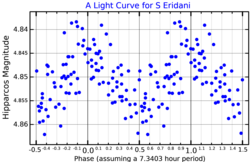 A light curve for S Eridani, adapted from Koen and Eyer (2002) | |
| Observation data Epoch J2000 Equinox | |
|---|---|
| Constellation | Eridanus |
| Right ascension | 04 59 55.73677 |
| Declination | −12° 32′ 14.6983″ |
| Apparent magnitude (V) | 4.77 |
| Characteristics | |
| Spectral type | F0 V |
| B−V color index | 0.266 |
| Variable type | δ Sct |
| Astrometry | |
| Radial velocity (Rv) | −8.9±4.2 km/s |
| Proper motion (μ) | RA: +39.67 mas/yr Dec.: −87.04 mas/yr |
| Parallax (π) | 12.0106 ± 0.2199 mas |
| Distance | 272 ± 5 ly (83 ± 2 pc) |
| Absolute magnitude (MV) | 0.03 |
| Details | |
| Mass | 1.52 M☉ |
| Luminosity | 80.17 L☉ |
| Surface gravity (log g) | 3.37 cgs |
| Temperature | 7,346±250 K |
| Rotational velocity (v sin i) | 212 km/s |
| Age | 644 Myr |
| Other designations | |
| 64 Eri, S Eri, BD−12° 1047, HD 32045, HIP 23231, HR 1611, SAO 150064 | |
| Database references | |
| SIMBAD | data |
64 Eridani is a single, yellow-white hued star in the constellation Eridanus having variable star designation S Eridani. It is faintly visible to the naked eye with an apparent visual magnitude of 4.77. The annual parallax shift is measured at 12.01 mas, which equates to a distance of about 272 light years. In addition to its proper motion, it is moving closer to the Sun with a radial velocity of around −9 km/s.
This is an F-type main-sequence star with a stellar classification of F0 V. It is catalogued a low amplitude Delta Scuti variable with a primary period of 0.273 days. It was originally classified, tentatively, as an RR Lyrae variable of type 'c'.
64 Eridani is spinning rapidly with a projected rotational velocity of 212 km/s. This is giving the star an oblate shape with an equatorial bulge; its equatorial radius is 8% larger than its polar radius. The star is an estimated 644 million years old with 1.5 times the mass of the Sun. It is radiating 80 times the Sun's luminosity from its photosphere at an effective temperature of roughly 7,346 K.
References
- Koen, Chris; Eyer, Laurent (March 2002). "New periodic variables from the Hipparcos epoch photometry". Monthly Notices of the Royal Astronomical Society. 331 (1): 45–59. arXiv:astro-ph/0112194. Bibcode:2002MNRAS.331...45K. doi:10.1046/j.1365-8711.2002.05150.x.
- ^ van Leeuwen, F. (November 2007), "Validation of the new Hipparcos reduction", Astronomy and Astrophysics, 474 (2): 653–664, arXiv:0708.1752, Bibcode:2007A&A...474..653V, doi:10.1051/0004-6361:20078357, S2CID 18759600.
- ^ Høg, E.; et al. (2000), "The Tycho-2 catalogue of the 2.5 million brightest stars", Astronomy and Astrophysics, 355: L27, Bibcode:2000A&A...355L..27H, doi:10.1888/0333750888/2862.
- ^ Houk, Nancy; Smith-Moore, M. (1978), Michigan catalogue of two-dimensional spectral types for the HD stars, vol. 4, Ann Arbor: Dept. of Astronomy, University of Michigan, Bibcode:1988mcts.book.....H.
- ^ Rodríguez, E.; Breger, M. (January 2001), "delta Scuti and related stars: Analysis of the R00 Catalogue", Astronomy and Astrophysics, 366: 178–196, Bibcode:2001A&A...366..178R, doi:10.1051/0004-6361:20000205.
- ^ de Bruijne, J. H. J.; Eilers, A.-C. (October 2012), "Radial velocities for the HIPPARCOS-Gaia Hundred-Thousand-Proper-Motion project", Astronomy & Astrophysics, 546: 14, arXiv:1208.3048, Bibcode:2012A&A...546A..61D, doi:10.1051/0004-6361/201219219, S2CID 59451347, A61.
- ^ Brown, A. G. A.; et al. (Gaia collaboration) (August 2018). "Gaia Data Release 2: Summary of the contents and survey properties". Astronomy & Astrophysics. 616. A1. arXiv:1804.09365. Bibcode:2018A&A...616A...1G. doi:10.1051/0004-6361/201833051. Gaia DR2 record for this source at VizieR.
- ^ Anderson, E.; Francis, Ch. (2012), "XHIP: An extended hipparcos compilation", Astronomy Letters, 38 (5): 331, arXiv:1108.4971, Bibcode:2012AstL...38..331A, doi:10.1134/S1063773712050015, S2CID 119257644.
- ^ David, Trevor J.; Hillenbrand, Lynne A. (2015), "The Ages of Early-Type Stars: Strömgren Photometric Methods Calibrated, Validated, Tested, and Applied to Hosts and Prospective Hosts of Directly Imaged Exoplanets", The Astrophysical Journal, 804 (2): 146, arXiv:1501.03154, Bibcode:2015ApJ...804..146D, doi:10.1088/0004-637X/804/2/146, S2CID 33401607.
- ^ Royer, F.; et al. (February 2007), "Rotational velocities of A-type stars. III. Velocity distributions", Astronomy and Astrophysics, 463 (2): 671–682, arXiv:astro-ph/0610785, Bibcode:2007A&A...463..671R, doi:10.1051/0004-6361:20065224, S2CID 18475298.
- "64 Eri". SIMBAD. Centre de données astronomiques de Strasbourg. Retrieved 2018-01-29.
- Eggleton, P. P.; Tokovinin, A. A. (September 2008), "A catalogue of multiplicity among bright stellar systems", Monthly Notices of the Royal Astronomical Society, 389 (2): 869–879, arXiv:0806.2878, Bibcode:2008MNRAS.389..869E, doi:10.1111/j.1365-2966.2008.13596.x, S2CID 14878976.
- Samus, N. N.; et al. (2017), "General Catalogue of Variable Stars", Astronomy Reports, 5.1, 61 (1): 80–88, Bibcode:2017ARep...61...80S, doi:10.1134/S1063772917010085, S2CID 125853869, retrieved 2019-08-06.
- Belle, G. T. (2012). "Interferometric observations of rapidly rotating stars". The Astronomy and Astrophysics Review. 20 (1): 51. arXiv:1204.2572. Bibcode:2012A&ARv..20...51V. doi:10.1007/s00159-012-0051-2. S2CID 119273474.